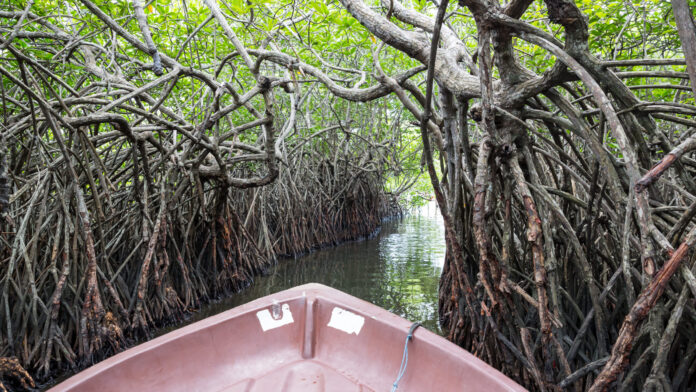Measuring Impact in Sri Lanka’s Scenic Spots
Frontpage Journal | July 2025
Sri Lanka’s scenic beauty has always been its calling card. From the windswept heights of Ella to the quiet mangroves of Kalpitiya, the island’s diverse landscapes attract visitors from every corner of the globe. Yet as tourism rebounds, so does its carbon footprint. Transportation, accommodation, energy use, and even the waste left behind on trails all contribute to environmental degradation. While promoting nature-based tourism is often framed as a sustainable strategy, its benefits vanish without rigorous systems to measure and manage its environmental costs. If Sri Lanka wants to claim leadership in sustainable tourism, it must first quantify what it consumes.
Measuring carbon footprints in tourism is complex but critical. A single tourist’s journey involves international air travel, domestic transport, energy-intensive accommodations, food consumption, and the impact of activities like boating or hiking. Each element has a calculable carbon cost. Without granular data, policymakers, businesses, and conservationists operate in the dark, unable to make informed decisions or set meaningful targets. The absence of measurement allows greenwashing to flourish, while genuinely sustainable practices go unnoticed and unrewarded.
Globally, countries and tourism boards are investing in tourism carbon calculators, GIS-based monitoring, and digital dashboards to quantify visitor impact. These tools not only measure emissions but also identify hotspots where pressure exceeds carrying capacity. In New Zealand, for example, regional tourism organizations use real-time data to assess trail erosion, waste accumulation, and energy use, adjusting visitor flows accordingly. The Netherlands has implemented smart tourism zones with carbon impact alerts and resource demand forecasting. Sri Lanka must look closely at such models, not just to replicate them but to contextualize them.
Key scenic regions like the Knuckles Mountain Range, Horton Plains, Sinharaja Forest Reserve, and the Southern coastal belt are already experiencing signs of stress. Increased vehicular traffic, littering, plastic pollution, and unsustainable water use are eroding the ecological character that makes these destinations attractive in the first place. Visitor numbers are growing faster than infrastructure or conservation capacity. But these trends remain anecdotal because Sri Lanka lacks a unified national system for environmental impact monitoring in tourism hotspots.
A national carbon accounting framework for tourism would be a foundational step. This framework should include emission benchmarks for different types of accommodations, transport modes, and tourism activities. It should be supported by digital tools that allow hotels, tour operators, and even tourists to measure and report their emissions. For example, hotels could report energy consumption through standard templates tied to certification incentives. Tour operators could log mileage and fuel types. Tourists could receive automated estimates of their trip’s carbon footprint and suggestions for mitigation, such as opting for low-emission transport or contributing to reforestation programs.
This effort must be supported by public-private collaboration. The Sri Lanka Tourism Development Authority (SLTDA), environmental agencies, travel platforms, and academic institutions can form a data alliance to pool information and standardize measurement. Universities already working on climate and energy modeling could be commissioned to build localized carbon calculators. Travel platforms like booking engines and review sites could integrate these calculators at the point of sale, encouraging responsible choices at the time of booking.
Another avenue is to create carbon-tagged travel itineraries, packages that provide detailed environmental impact assessments alongside cultural and ecological highlights. Such transparency builds trust with climate-conscious travelers and opens new marketing opportunities. Imagine a tourist choosing between two beach destinations not only on aesthetics but on relative emissions and plastic waste generation. The one offering lower impact may become the preferred option for responsible visitors.
Tracking is only the beginning. Mitigation strategies must follow measurement. Tourist-heavy zones can adopt offset mechanisms such as reforestation, mangrove restoration, or solar-powered infrastructure. Hotels can invest in energy-efficient appliances, water recycling systems, and zero-waste kitchens. Transport providers can transition to electric fleets or incentivize group travel to reduce per capita emissions. These measures are more likely to be adopted if they are tied to recognition, subsidies, or market access advantages.
However, data without governance is ineffective. A regulatory framework is needed to mandate impact disclosures, enforce emission limits in sensitive areas, and penalize high-impact practices. This does not mean adding bureaucracy. Rather, it means embedding environmental accountability into the license renewal process, promotional campaigns, and incentive schemes. Just as food establishments require health certifications, tourism entities should demonstrate environmental compliance as part of their operational legitimacy.
Visitors themselves have a role to play. Awareness campaigns at airports, train stations, and online platforms can educate tourists about the cumulative footprint of their behavior. Signs along popular trails could display real-time statistics about the number of visitors that day and their estimated impact. Nudges like refill water stations and reusable bag kiosks reinforce low-carbon choices. Some destinations globally have introduced carbon levies on hotel stays or park entries, with revenues earmarked for local conservation. Sri Lanka could pilot such initiatives in partnership with community organizations to ensure transparency and local benefit.
The tourism sector cannot insulate itself from climate accountability. Emissions from travel are now under the scrutiny of ESG investors, sustainability auditors, and international donors. Countries without robust monitoring systems risk exclusion from emerging green finance instruments and sustainable travel indices. More importantly, they risk undermining the very ecosystems that drive their appeal. For Sri Lanka, building a reputation as a low-impact, high-integrity destination will depend on its ability to turn scenic beauty into sustainable infrastructure, measured, managed, and protected.
Carbon measurement is not a niche environmental exercise. It is a strategic necessity for a tourism industry that wants to scale responsibly, attract premium travelers, and align with the future of global travel. Scenic spots may attract the first visit. But only sustainability will bring the second.




